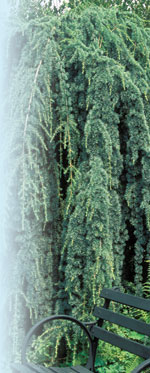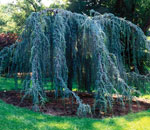Use Weeping Blue Atlas Cedar as Landscape Feature
go.ncsu.edu/readext?232841
en Español / em Português
El inglés es el idioma de control de esta página. En la medida en que haya algún conflicto entre la traducción al inglés y la traducción, el inglés prevalece.
Al hacer clic en el enlace de traducción se activa un servicio de traducción gratuito para convertir la página al español. Al igual que con cualquier traducción por Internet, la conversión no es sensible al contexto y puede que no traduzca el texto en su significado original. NC State Extension no garantiza la exactitud del texto traducido. Por favor, tenga en cuenta que algunas aplicaciones y/o servicios pueden no funcionar como se espera cuando se traducen.
Português
Inglês é o idioma de controle desta página. Na medida que haja algum conflito entre o texto original em Inglês e a tradução, o Inglês prevalece.
Ao clicar no link de tradução, um serviço gratuito de tradução será ativado para converter a página para o Português. Como em qualquer tradução pela internet, a conversão não é sensivel ao contexto e pode não ocorrer a tradução para o significado orginal. O serviço de Extensão da Carolina do Norte (NC State Extension) não garante a exatidão do texto traduzido. Por favor, observe que algumas funções ou serviços podem não funcionar como esperado após a tradução.
English
English is the controlling language of this page. To the extent there is any conflict between the English text and the translation, English controls.
Clicking on the translation link activates a free translation service to convert the page to Spanish. As with any Internet translation, the conversion is not context-sensitive and may not translate the text to its original meaning. NC State Extension does not guarantee the accuracy of the translated text. Please note that some applications and/or services may not function as expected when translated.
Collapse ▲
Cedrus atlantica ‘Glauca Pendula’
Robert E. Lyons ©
Many gardeners are familiar with the wonderful ornamental attributes and landscape use of deodar cedar (Cedrus deodara), with its beautiful blue-green leaves and graceful habit. Its unusual-looking cousin, weeping blue atlas cedar, C. atlantica ‘Glauca Pendula’, deserves recognition as well. This is truly a unique plant. Its branches feature a flowing effect, sometimes described as cascading like water over a bed of rocks. This wonderful weeping conifer has the same evergreen, bluish needles as the common deodar cedar. The weeping, twisting, long branches that are crowded with bright blue needles fall down around the trunk.
Weeping blue atlas cedar, with its unusual characteristics, is a perfect candidate as a specimen plant. The plant deserves a special place where it will be sure to catch the eye and hold the interest of any visitor to the garden. It can be trained, trellised, espaliered and even grown as a bonsai to fit the need and size desired in the garden. Its twisted branch habit gives it year-round interest.

Cedrus atlantica ‘Glauca Pendula’
Robert E. Lyons ©
As with most cedars, weeping blue atlas cedar does best in loamy soil and full sun but will tolerate other soils except those with poor drainage. It is a moderate to slow-growing evergreen, growing to 10 feet tall and 15 feet wide. It is somewhat difficult to transplant so it is best to plant container grown trees. Staking and training young trees is necessary to establish the desired form.
Blue atlas cedar is resistant to serious pest and disease problems. Protect trees from strong winter winds since cold temperatures can injure or kill tops of established trees.
You can find a young weeping blue atlas cedar at the JC Raulston Arboretum on the south side of the visitor center. An older specimen is found in the Klein-Pringle White Garden.


